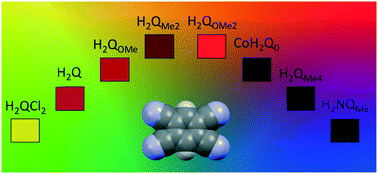Series of charge transfer complexes obtained as crystals in a confined environment†
Abstract
A series of charge transfer complexes (CTCs) were successfully formed by solvent free processing techniques, using the 1,2,4,5-tetracyano benzene (TCNB) as πA molecule and a series of p-dihydroquinones (H2Qs) as πD counterparts. Additionally to the classical co-evaporation techniques, we obtained CTCs in less than an hour, in a very simple confined environment, between two 100 μm – spaced glass plates. A systematical study by Raman spectroscopy on crystals highlighted the CTCs formation. Moreover, three new crystalline structures were obtained, namely TCNB-H2Q that crystallizes in columns connected to each other by H-bonds, while with the methoxy- and dimethoxy-H2Qs the CTC forms crystals with the stoichiometry 1 : 2, TCNB-(H2QOMe)2 and TCNB-(H2QOMe2)2. In TCNB-(H2QOMe)2 layers are formed due to intermolecular hydrogen bonds, while in TCNB-(H2QOMe2)2 molecules arrange in triads, with πA–πD interactions. In all cases, strong πA–πD interactions exist with intermolecular distances lower than the van der Waals distances, which results in strong absorption bands in the visible range.

- This article is part of the themed collection: Crystal Engineering Techniques


 Please wait while we load your content...
Please wait while we load your content...